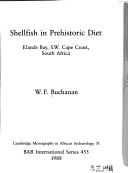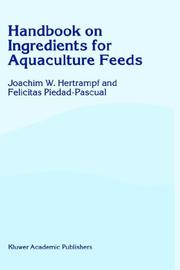| Listing 1 - 10 of 15 | << page >> |
Sort by
|
Periodical
Abstract | Keywords | Export | Availability | Bookmark
 Loading...
Loading...Choose an application
- Reference Manager
- EndNote
- RefWorks (Direct export to RefWorks)
Fishes --- Shellfish --- Crustacea --- Mollusca --- Immunology --- immunology --- Poissons --- Crustacés --- Immunologie --- Shell-fish --- Shellfishes --- Fish --- Pisces --- Aquatic invertebrates --- Aquatic animals --- Vertebrates --- Fisheries --- Fishing --- Ichthyology
Book
ISBN: 1845695577 1601197918 1420077929 1845691520 9781845695576 9781845691523 9781420077926 9781845691523 9781420077926 9781601197917 Year: 2009 Publisher: Cambridge, England Boca Raton, Florida
Abstract | Keywords | Export | Availability | Bookmark
 Loading...
Loading...Choose an application
- Reference Manager
- EndNote
- RefWorks (Direct export to RefWorks)
Shellfish are a very popular and nutritious food source worldwide and their consumption has risen dramatically. Because of their unique nature as compared to beef and poultry, shellfish have their own distinct aspects of harvest, processing and handling. Edited by leading authorities in the field, this collection of review papers discusses issues of current interest and outlines steps that can be taken by the shellfish industry to improve shellfish safety and eating quality.Opening chapters provide an overview of the key issues associated with microbial and biotoxin contamination. Parts two an
Shellfish. --- Shellfish as food --- Safety measures. --- Quality. --- Contamination. --- Food contamination --- Seafood --- Shell-fish --- Shellfishes --- Aquatic invertebrates --- Engineering --- Food Science and Technology
Book
ISBN: 0128213388 012821337X 9780128213384 9780128213377 Year: 2021 Publisher: London Academic Press
Abstract | Keywords | Export | Availability | Bookmark
 Loading...
Loading...Choose an application
- Reference Manager
- EndNote
- RefWorks (Direct export to RefWorks)
Aquaculture Toxicology is an essential resource of practical information that covers mechanisms of toxicity and their responses to toxic agents, including aspects of uptake, metabolism and excretion of toxicants in fish, crustaceans and mollusks. This is a reliable, up-to-date, “all inclusive” reference guide that provides an understanding of toxicology information for the aquaculture industry. Written by respected international experts recognized in specific areas of toxicology, this book covers toxins at the environmental, cellular and molecular levels. It identifies areas where more research is needed to generate more knowledge to support a sustainable aquaculture industry, including pharmaceutical pollutants and microplastics.--
Shellfish --- Diseases. --- Shell-fish --- Shellfishes --- Aquatic invertebrates --- Aquaculture --- Fishes --- Environmental aspects. --- Effect of water pollution on. --- Aquiculture --- Agriculture --- Fishes, Effect of water pollution on --- Fish kills
Periodical
ISSN: 19436319 Year: 1981 Publisher: [Place of publication not identified] : [National Shellfisheries Association]
Abstract | Keywords | Export | Availability | Bookmark
 Loading...
Loading...Choose an application
- Reference Manager
- EndNote
- RefWorks (Direct export to RefWorks)
Shellfish --- Shellfish culture --- Shellfish fisheries --- JEX6 --- Crustacean fisheries --- Mollusk fisheries --- Shellfisheries --- Farming, Shellfish --- Shellfish aquaculture --- Shellfish cultivation --- Shellfish farming --- Shell-fish --- Shellfishes --- Cultivation --- Cultures and culture media --- Fisheries --- Aquaculture --- Aquatic invertebrates --- Shellfish. --- Shellfish culture. --- Shellfish fisheries.
Book
ISBN: 0444422099 9780444422095 Year: 1983 Volume: 12 Publisher: Amsterdam Elsevier
Abstract | Keywords | Export | Availability | Bookmark
 Loading...
Loading...Choose an application
- Reference Manager
- EndNote
- RefWorks (Direct export to RefWorks)
Fishes --- Aquaculture --- Shellfish --- Genetics --- Congresses --- -Fishes --- -Shellfish --- -Shell-fish --- Shellfishes --- Aquatic invertebrates --- Fish --- Pisces --- Aquatic animals --- Vertebrates --- Fisheries --- Fishing --- Ichthyology --- Aquiculture --- Agriculture --- -Congresses --- Fishes - Genetics - Congresses --- Aquaculture - Congresses --- Shellfish - Genetics - Congresses
Book
ISBN: 9811619034 9811619026 Year: 2021 Publisher: Singapore : Springer,
Abstract | Keywords | Export | Availability | Bookmark
 Loading...
Loading...Choose an application
- Reference Manager
- EndNote
- RefWorks (Direct export to RefWorks)
Fishes --- Shellfish --- Diseases. --- Shell-fish --- Shellfishes --- Aquatic invertebrates --- Fish diseases --- Fish kills --- Diseases and pests --- Malalties dels peixos --- Virus --- Microbis --- Ultravirus --- Bacteris --- Microorganismes --- Vectors genètics --- Bacteriòfags --- Virus ADN --- Virus RNA --- Virus oncogènics --- Malalties víriques --- Virologia --- Malalties dels animals --- Malalties infeccioses en els peixos

ISBN: 0860545849 Year: 1988 Volume: vol 455 vol 31 Publisher: Oxford : BAR,
Abstract | Keywords | Export | Availability | Bookmark
 Loading...
Loading...Choose an application
- Reference Manager
- EndNote
- RefWorks (Direct export to RefWorks)
Kitchen-middens --- -Shellfish --- -Stone age --- -Prehistoric peoples --- -Animal remains (Archaeology) --- -Archaeozoology --- Zooarchaeology --- Zoology in archaeology --- Archaeology --- Bones --- Animal paleopathology --- Cavemen (Prehistoric peoples) --- Early man --- Man, Prehistoric --- Prehistoric archaeology --- Prehistoric human beings --- Prehistoric humans --- Prehistory --- Human beings --- Antiquities, Prehistoric --- Civilization --- Shell-fish --- Shellfishes --- Aquatic invertebrates --- Middens, Kitchen --- Sambaquis --- Shell heaps --- Shell middens --- Shell mounds --- Animal remains (Archaeology) --- Indians of North America --- Terremare --- Food --- Methodology --- Antiquities --- Elands Bay Region (South Africa) --- -Antiquities --- Prehistoric peoples --- Shellfish --- Stone age --- -Food --- Archaeozoology --- Antiquities. --- Primitive societies

ISBN: 0412627604 1402015275 9401140189 9781402015274 Year: 2000 Publisher: Dordrecht : Kluwer,
Abstract | Keywords | Export | Availability | Bookmark
 Loading...
Loading...Choose an application
- Reference Manager
- EndNote
- RefWorks (Direct export to RefWorks)
Current growth in global aquaculture is paralleled by an equally significant increase in companies involved in aquafeed manufacture. Latest information has identified over 1,200 such companies, not including those organizations in production of a variety of other materials, i. e. , vitamins, minerals, and therapeutics, all used in varying degrees in proper feed formulation. Aquaculture industries raising particular economically valued species, i. e. , penaeid shrimps and salmonids, are making major demands on feed ingredients, while relatively new industries, such as til apia farming, portent a significant acceleration in demand for properly formulated aquafeeds by the end of the present decade and into the next century. As requirements for aquafeeds increases, shortages are anticipated in various ingredients, especially widely used proteinaceous resources such as fish meal. A variety of other proteinaceous commodities are being considered as partial or complete replacement for fish meal, especially use of plant protein sources such as soybean meal. In the past five years, vegetable protein meal production has increased 10% while fish meal production has dropped over 50%, since 1989, largely attributed to overfishing and serious decline in wild stock. Throughout fisheries processing industries, traditional concepts as "waste" have given way to more prudent approaches, emphasizing total by-product recovery. Feed costs are a major consideration in aquaculture where in some groups, i. e. , salmonids, high protein-containing feeds using quality fish meal, can account for as much as 40 to 60% of production costs.
639.3.043 --- Feeding, nutrition of fish. Fish foods --- Fishes --- Shellfish --- Zoology and Animal Sciences. Aquaculture and Fisheries --- Feeding and feeds. --- Nutrition. --- Aquaculture --- Nutrition and Feeding --- Earth & Environmental Sciences --- Ecology --- Agriculture --- Animal Sciences --- Feeding and feeds --- Nutrition --- Nutrition and Feeding. --- 639.3.043 Feeding, nutrition of fish. Fish foods --- Shell-fish --- Shellfishes --- Aquatic invertebrates --- Food --- Aquatic ecology . --- Food—Biotechnology. --- Animal physiology. --- Freshwater & Marine Ecology. --- Food Science. --- Animal Physiology. --- Animal physiology --- Animals --- Biology --- Anatomy --- Aquatic biology --- Physiology
Periodical
ISSN: 21537720 Publisher: Washington, D.C. U.S. Dept. of Agriculture, Agricultural Research Service
Abstract | Keywords | Export | Availability | Bookmark
 Loading...
Loading...Choose an application
- Reference Manager
- EndNote
- RefWorks (Direct export to RefWorks)
Shellfish as carriers of disease --- Shellfish as food --- Shellfish culture --- Pathogenic microorganisms --- Shellfish --- Detection --- Contamination --- Microbiology --- Safety measures --- Viruses --- Detection. --- Detection of pathogenic microorganisms --- Diagnostic microbiology --- Shell-fish --- Shellfishes --- Aquatic invertebrates --- Disease-causing microorganisms --- Micro-organisms, Pathogenic --- Pathogens --- Microorganisms --- Medical microbiology --- Virulence (Microbiology) --- Farming, Shellfish --- Shellfish aquaculture --- Shellfish cultivation --- Shellfish farming --- Aquaculture --- Seafood --- Shellfish vectors --- Invertebrates as carriers of disease --- Cultivation --- Cultures and culture media
Book
ISBN: 9789251069332 Year: 2011 Publisher: Rome : FAO,
Abstract | Keywords | Export | Availability | Bookmark
 Loading...
Loading...Choose an application
- Reference Manager
- EndNote
- RefWorks (Direct export to RefWorks)
The rise into global prominence and rapid growth of finfish and crustacean aquaculture has been due, in part, to the availability and on-farm provision of feed inputs within the major producing countries. More than 46 percent of the total global aquaculture production in 2008 was dependent upon the supply of external feed inputs. For the aquaculture sector to maintain its current average growth rate of 8 to 10 percent per year to 2025, the supply of nutrient and feed inputs will have to grow at a similar rate. This had been readily attainable when the industry was young. It may not be the case anymore as the sector has grown into a major consumer of and competitor for feed resources. This paper reviews the dietary feeding practices employed for the production of the major cultured fed species, the total global production and market availability of the major feed ingredient sources used and the major constraints to feed ingredient usage, and recommends approaches to feed ingredient selection and usage for the major species of cultivated fish and crustacean. Emphasis is placed on the need for major producing countries to maximize the use of locally available feed-grade ingredient sources, and, in particular, to select and use those nutritionally sound and safe feed ingredient sources whose production and growth can keep pace with the 8 to 10 percent annual average annual growth of the fed finfish and crustacean aquaculture sector.
Fish culture. --- Fish culture --- Fish feeding --- aquaculture. --- aquaculture --- Crustacean culture --- Animal feeding --- animal nutrition --- world --- Hatchery fishes --- Shellfish culture --- Shellfish --- 639.3.043 --- Shell-fish --- Shellfishes --- Aquatic invertebrates --- Farming, Shellfish --- Shellfish aquaculture --- Shellfish cultivation --- Shellfish farming --- Aquaculture --- Fish hatchery fishes --- Hatchery fish --- Hatchery-reared fish --- Hatchery-reared fishes --- Fishes --- Fish hatcheries --- Artificial propagation of fishes --- Culture, Fish --- Farming, Fish --- Fish aquaculture --- Fish farming --- Fish husbandry --- Fish rearing --- Pisciculture --- Rearing of fishes --- Animal culture --- 639.3.043 Feeding, nutrition of fish. Fish foods --- Feeding, nutrition of fish. Fish foods --- Feeding and feeds --- Nutrition --- Cultivation --- Cultures and culture media --- Culture --- Farming --- Husbandry --- Rearing
| Listing 1 - 10 of 15 | << page >> |
Sort by
|

 Search
Search Feedback
Feedback About UniCat
About UniCat  Help
Help News
News